转:解释lsh
Locality sensitive hashing — LSH explained
The problem of finding duplicate documents in a list may look like a simple task — use a hash table, and the job is done quickly and the algorithm is fast. However, if we need to find not only exact duplicates, but also documents with differences such as typos or different words, the problem becomes much more complex. In my case, I’ve had to find duplicates in a very long list of given questions.
Jaccard index
First, we need to define a method of determining whether a question is a duplicate of another. After experimenting with string distance metrics (Levenshtein, Jaro-Winkler, Jaccard index) I’ve come to the conclusion that the Jaccard index performs sufficiently for this use case. The Jaccard index is an intersection over a union. We count the amount of common elements from two sets, and divide by the number of elements that belong to either the first set, the second set, or both. Let’s have a look at the example:
Assuming that we have two following questions:
“Who was the first ruler of Poland”
“Who was the first king of Poland”
We can visualize it in the following sets:
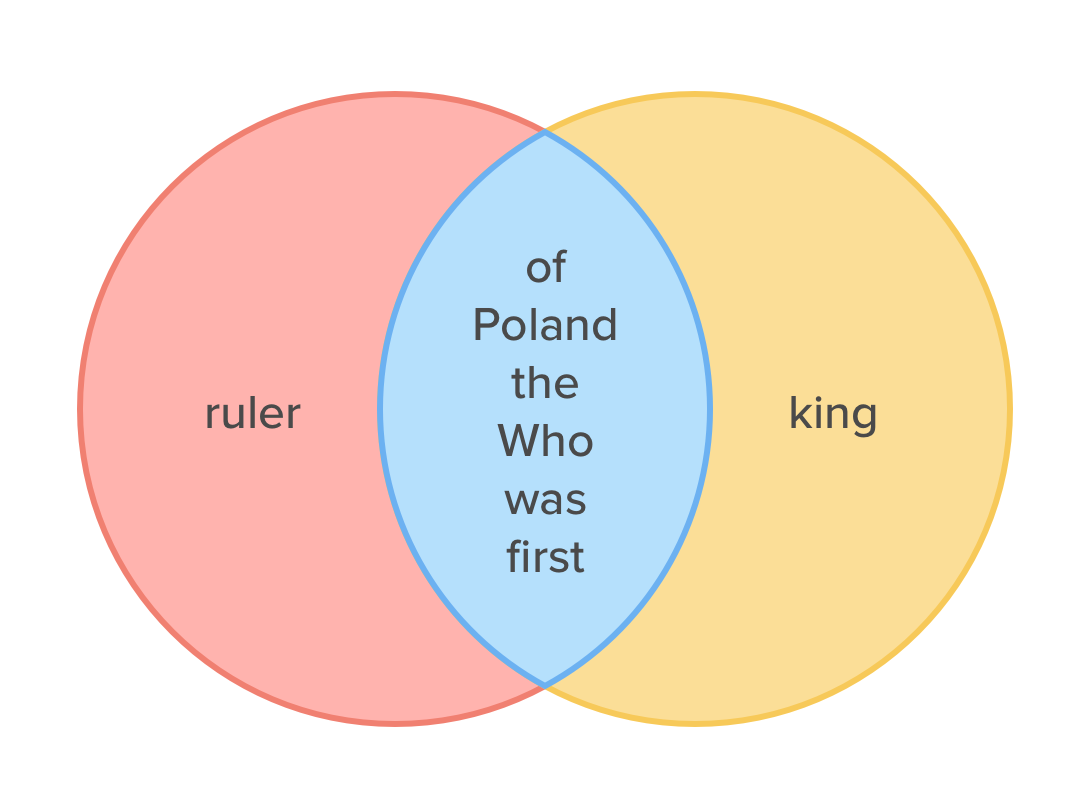
The size of the intersection is 6, while the size of the union is 6 + 1 + 1 = 8, thus the Jaccard index is equal to 6 / 8 = 0.75
We can conclude — the more common words, the bigger the Jaccard index, the more probable it is that two questions are a duplicate. So where we can set a threshold above which pairs would be marked as a duplicate? For now, let’s assume 0.5 as a threshold, but in a real life, we need to get this value by experiment. We could stop here, but current solution makes a number of comparisons growing quadratically (It’s 0.5*(n²-n) where n is the number of questions).
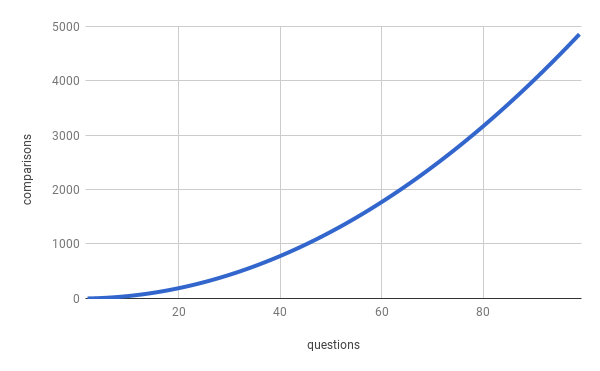
Min part of MinHash
It’s been shown earlier that the Jaccard can be a good string metric, however, we need to split each question into the words, then, compare the two sets, and repeat for every pair. The amount of pairs will grow rapidly. What if we somehow created a simple fixed-size numeric fingerprint for each sentence and then just compare the fingerprints?
In this section I will use following questions:
“Who was the first king of Poland”
“Who was the first ruler of Poland”
“Who was the last pharaoh of Egypt”
And their Jaccard indexes:
J(“Who was the first king of Poland”, “Who was the first ruler of Poland”) = 0.75
J(“Who was the first king of Poland”,“Who was the last pharaoh of Egypt”) = 0.4
J(“Who was the first ruler of Poland”, “Who was the last pharaoh of Egypt”)=0.4
To calculate MinHash we need to create the dictionary (a set of all words) from all our questions. Then, create a random permutation:
(“last”, “Who”, “Egypt”, “king”, “ruler”, “was”, “of”, “Poland”, “pharaoh”, “the”, “first”)
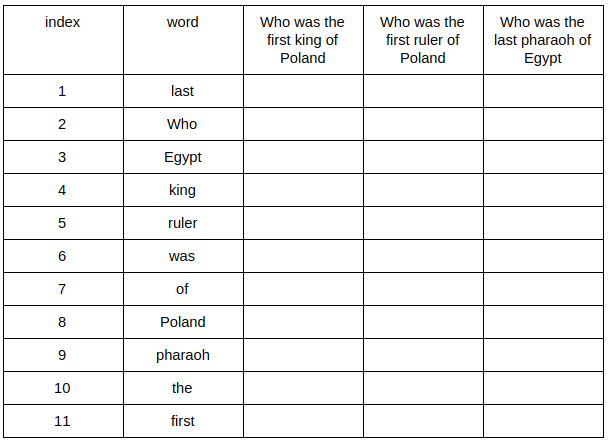
We have to iterate over the rows, writing the index in the respective cell, if the word being checked is present in the sentence.

Now the second row:

And the rest:
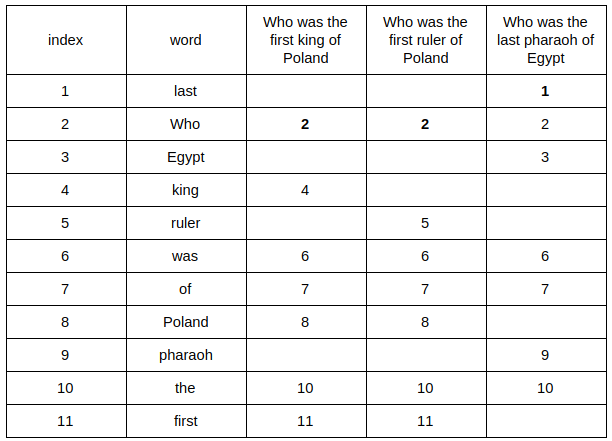
Only the first word occurrence is relevant (giving a minimal index — hence the name MinHash). We have a minimum value for all our questions and the first part of the fingerprint. To get the second one we need to create another random permutation and retrace our steps: /////只有出现的第一个单词是相关的(给出最小索引,因此命名为MinHash)。我们对所有的问题和指纹的第一部分都有一个最小值。为了得到第二个,我们需要创建另一个随机排列,并返回我们的步骤
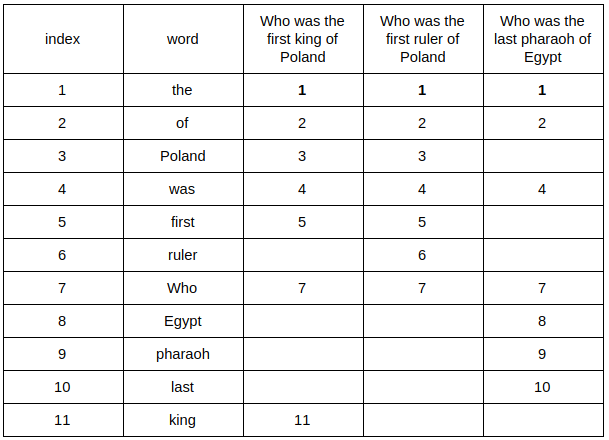
Then, we repeat permuting and searching as many times as big we want our fingerprint. For the purpose of example my consists of 6 items. We’ve already had 2, so let’s create 4 more permutations:
(“first”, “king”, “Egypt”, “was”, “Who”, “of”, “pharaoh”, “last”, “Poland”, “ruler”, “the”)
(“ruler”, “king”, “Poland”, “Who”, “the”, “pharaoh”, “of”, “first”, “Egypt”, “last”, “was”)
(“king”, “Poland”, “ruler”, “last”, “pharaoh”, “the”, “Who”, “Egypt”, “first”, “of”, “was”)
(“the”, “pharaoh”, “Who”, “ruler”, “Poland”, “Egypt”, “king”, “last”, “was”, “first”, “of”)
Our complete MinHashes are:
MinHash(“Who was the first king of Poland”) = [2, 1, 1, 2, 1, 1]
MinHash(“Who was the first ruler of Poland”) = [2, 1, 1, 1, 1, 1]
MinHash(“Who was the last pharaoh of Egypt”) = [1, 1, 3, 4, 4, 1]
Now we can check how similar are two MinHashes by calculating their Jaccard indexes:
MinHashSimilarity(“Who was the first king of Poland”, “Who was the first ruler of Poland”) = 5/6 ≈ 0.83
MinHashSimilarity(“Who was the first king of Poland”, “Who was the last pharaoh of Egypt”) = 2/6 ≈ 0.33
MinHashSimilarity(“Who was the first ruler of Poland”, “Who was the last pharaoh of Egypt”) = 2/6 ≈ 0.33
Well, that’s really close to their Jaccard indexes, and the more permutations we do, the closer the approximations get. How’s that possible?
Let’s analyze how we calculate the Jaccard index. We need to look at our table. Considering only two questions, we can create a table like the following:
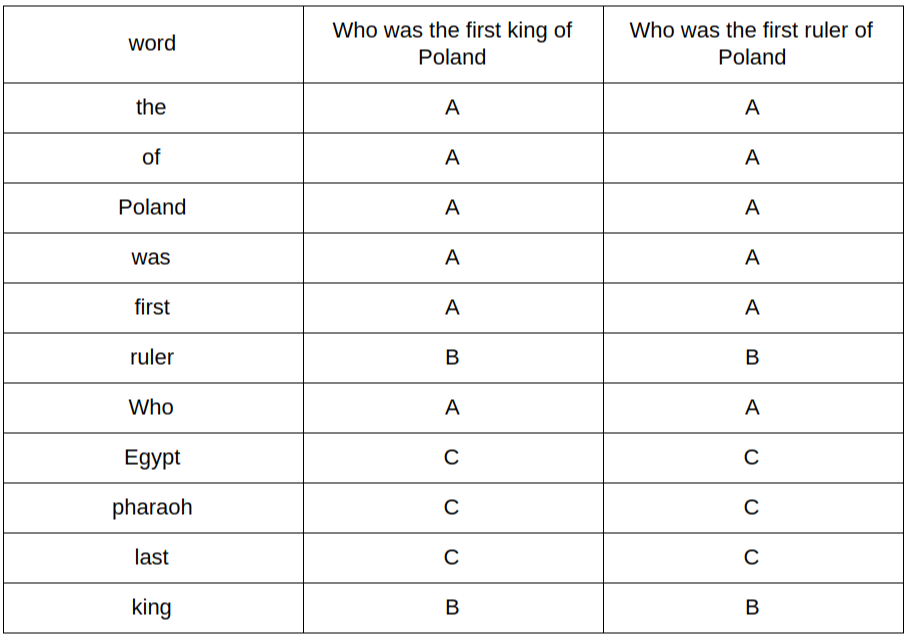
A — where the word is present in both questions
B —it’s present in one of them
C — it’s in the dictionary, but in neither of the questions
We can write the formula for the Jaccard index as a/(a+b) where a is a number of rows of type A and b of type B
Now since we have random permutations, let’s count a probability that two questions will have an equal fingerprint component. We can skip type C rows since they do not interfere in any way with a component value calculation (If we consider only two questions). So what is the probability that we will take type A row, from the set of A and B rows? P = a/(a + b) which is exactly the same as Jaccard index! That explains why our approximations were close and why more permutations mean better approximations.
Hash part of MinHash
We now have an algorithm which could potentially perform better, but the more documents the bigger the dictionary, and thus the higher the cost of creating permutations, both in time and hardware. Instead of creating n permutations we can take a hash function (like md5, sha256 etc.) use it on every word in the question and find a minimal hash value. It will be the first element of the fingerprint, then we will take another hash function, and so on until we have our n elements in the fingerprint. Wait, but why does it work?
Let’s wonder what permutation does — it basically maps each word from dictionary to a different number. The fact that mapped numbers are integers increased by one is not important to us.
What are hash functions doing? Simplifying — they map string to a number, so basically the same as the permutation! How is that better? We don’t need the whole dictionary before — if the new question appears we can easily calculate its MinHash. Also, we don’t need to scan the whole dictionary for each question and create a permutation of the whole dictionary. Both of these operations are pretty costly. We just saved a lot of our and our’s computer time.
So now we can compute a fingerprint and compare it easily, but still we need to compare every fingerprint with all others. This is bad. Exponentially bad.
LSH
Let’s look back at our MinHashes:
MinHash(“Who was the first king of Poland”) = [2, 1, 1, 2, 1, 1]
MinHash(“Who was the first ruler of Poland”) = [2, 1, 1, 1, 1, 1]
MinHash(“Who was the last pharaoh of Egypt”) = [1, 1, 3, 4, 4, 1]
Now group them by three elements:
MinHash(“Who was the first king of Poland”) =[2, 1, 1, 2, 1, 1] => [211, 211]
MinHash(“Who was the first ruler of Poland”) =[2, 1, 1, 1, 1, 1] => [211, 111]
MinHash(“Who was the last pharaoh of Egypt”)=[1, 1, 3, 4, 4, 1]=>[113,441]
What can we see? Our duplicates have one common group (first) where unique has no common groups. Since still, we’re talking about probability influenced issue let’s calculate what is the probability of at least one common group for duplicates:
- Probability of one specific element common in fingerprint = Jaccard index = P1 = 0.75
- Probability that all elements in one group are identical = Jaccard index to number of elements in group power = P2 = 0.75³ = 0.421875
- Probability that group will be different = P3 = 1-P2 = 0.578125
- Probability that all groups will be different = P4 to number of groups power = P3² = 0.334228516
- And finally — Probability that at least one group will be common = P5 = 1 — P4 = 0.665771484
So general equation will look like this: P5 = 1 — (1 — Jn)b
Where:
J — Jaccard index
n — number of elements in group
b — number of groups
And probability for our unique question is 1 — (1–0.4³)² = 0.123904 — much lower. We could also make 3 groups 2 elements each. Here is plot:
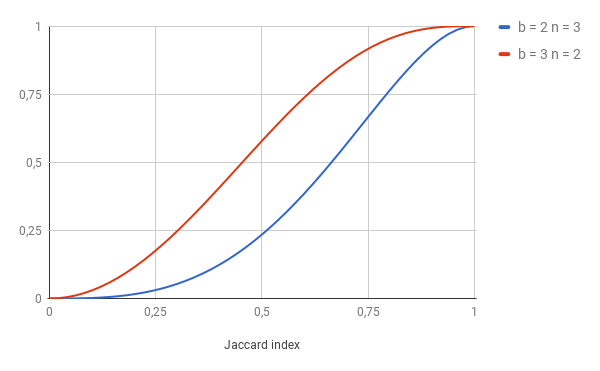
Let’s analyze it: For the pair with J = 0.5 and b = 3, there is only 0.25 probability that we would find it as a duplicate. However, with b = 3 there is about 0.6 probability that we would mark it as a duplicate. What does it mean in practice? — More false positives for b = 3 and more false negatives for b = 2. We need to choose carefully our parameters, but more on that later.
Now we do not need to count anything — if there is a common group we can mark it as duplicates. We can just create lists with single groups:
[211, 211]
[211, 111]
[113, 441]
↓
[
211 => “Who was the first king of Poland”,
211 => “Who was the first ruler of Poland”,
113 => “Who was the last pharaoh of Egypt”
]
And
[
211 => “Who was the first king of Poland”,
111 => “Who was the first ruler of Poland”,
441 => “Who was the last pharaoh of Egypt”
]
It looks familiar to Hashtable! We can put columns of groups in the hash table and check for collision. Collision means that we hit a duplicate. And operations on the hash table have worst case scenario complexity of O(n), so our algorithm (of course depends on implementation) have potential to be also O(n) complex. Way better than O(n²) we had at the beginning.
Tweaking
After what we’ve learned so far we know that LSH takes, 3 arguments:
k — number of elements in MinHash
n — number of elements in groups (or buckets)
b — number of buckets and b*n must equal k
Our goal is to mark as duplicate every pair, or more, that have Jaccard index >= 0.17, so our probability chart should look like this:
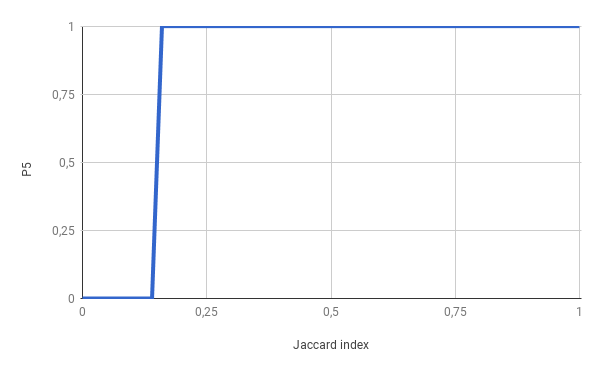
Achieving step function is impossible in our case, so by manipulating our 3 parameters we need to approximate this as close as possible having in mind that bigger the k, more computing power we need (more hashes to calculate). After experiments, I’ve found that 200 for k is good starting value and it also has many divisors. Although 240 has more, so it would be my next shot.
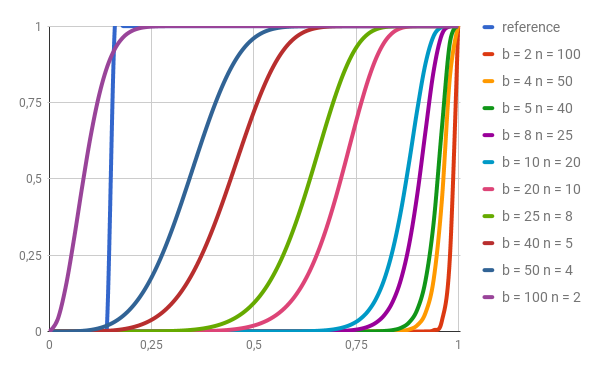
As we can see b = 100 n = 2 or b = 50 n = 4 are the ones closest to reference. We should use both and then compare results.
One thing left — where to get 200 hash functions? Two example solutions:
- use MurmurHash with 200 different seeds
- create our own hash function by taking the output of md5 or another hash function and making XOR with some random number. Example python code:
def myFirstHash(string):
return md5(hash) ^ 636192
def mySecondHash(string):
return md5(hash) ^ 8217622
# And so on.
# But do it in a loop!
Warning — LSH can, and sometimes will produce accidental collisions, so at the end, we still need to compare all questions in given collision but it will be much much fewer operations than comparing all to each other.
And that would be all for now. In next article, I will show example implementation and some benchmarks.
转自:
https://medium.com/engineering-brainly/locality-sensitive-hashing-explained-304eb39291e4
转:解释lsh的更多相关文章
- 实习日记:图像检索算法 LSH 的总结与分析(matlab)
最开始仿真和精度测试,基于 matlab 完成的. Demo_MakeTable.m (生成 Hash 表) %======================================== %** ...
- 海量数据挖掘MMDS week7: 局部敏感哈希LSH(进阶)
http://blog.csdn.net/pipisorry/article/details/49686913 海量数据挖掘Mining Massive Datasets(MMDs) -Jure Le ...
- 海量数据挖掘MMDS week2: 局部敏感哈希Locality-Sensitive Hashing, LSH
http://blog.csdn.net/pipisorry/article/details/48858661 海量数据挖掘Mining Massive Datasets(MMDs) -Jure Le ...
- Locality Sensitive Hashing,LSH
1. 基本思想 局部敏感(Locality Senstitive):即空间中距离较近的点映射后发生冲突的概率高,空间中距离较远的点映射后发生冲突的概率低. 局部敏感哈希的基本思想类似于一种空间域转换思 ...
- Halcon算子解释
Halcon算子解释大全 Halcon/Visionpro视频教程和资料,请访问 重码网,网址: http://www.211code.com Chapter 1 :Classification 1. ...
- BOW模型在ANN框架下的解释
原文链接:http://blog.csdn.net/jwh_bupt/article/details/17540561 作者的视野好,赞一个. 哥德尔第一完备性定理,始终是没有能看完完整的证明,艹!看 ...
- 图像检索中为什么仍用BOW和LSH
原文链接:http://blog.csdn.net/jwh_bupt/article/details/27713453 去年年底的时候在一篇博客中,用ANN的框架解释了BOW模型[1],并与LSH[2 ...
- 位姿检索PoseRecognition:LSH算法.p稳定哈希
位姿检索使用了LSH方法,而不使用PNP方法,是有一定的来由的.主要的工作会转移到特征提取和检索的算法上面来,有得必有失.因此,放弃了解析的方法之后,又放弃了优化的方法,最后陷入了检索的汪洋大海. 0 ...
- 从Go语言编码角度解释实现简易区块链
区块链技术 人们可以用许多不同的方式解释区块链技术,其中通过加密货币来看区块链一直是主流.大多数人接触区块链技术都是从比特币谈起,但比特币仅仅是众多加密货币的一种. 到底什么是区块链技术? 从金融学相 ...
随机推荐
- 差分进化算法介绍及matlab实现
引言 差分进化算法是基于群体智能理论的优化算法,是通过群体内个体间的合作与竞争而产生的智能优化搜索算法,它保留了基于种群的全局搜索策略,采用实数编码.基于差分的简单变异操作和"一对一&quo ...
- Cephfs的文件存到哪里了
前言 在ceph里面使用rbd接口的时候,存储的数据在后台是以固定的prifix的对象存在的,这样就能根据相同的前缀对象去对image文件进行拼接或者修复 在文件系统里面这一块就要复杂一些,本篇就写的 ...
- mysql数据库新增、修改、删除字段和修改表名
Mysql 删除,添加或修改表字段 删除 ALTER TABLE testalter_tbl DROP i; 新增 ALTER TABLE testalter_tbl ADD i INT; 指定位置新 ...
- 在IDM上设置防止过度抓取网站信息
在使用Internet Download Manager(IDM)下载器时,有时会发现IDM自带的抓取功能过于强大,以至于有时会抓取一些无效的链接.那么,该如何避免IDM的过度抓取呢? 图1:IDM的 ...
- 用Camtasia来快速地给视频添加水印
在日常生活中,视频的流行度越来越高,各种短视频的软件蜂拥上市,所以越来越多的人走上了自媒体的道路,在这条路上,谁的视频更加的精致,谁才能获得更多的关注度,相应的也能增加自己的人气. 但是在制作视频的过 ...
- 吉他指弹入门——贝斯(walking bass)
在每一个乐队中都有一个神秘而低调的乐手,在现场演奏中你甚至感觉不到他的存在,但是他又异常重要.即是鼓手打拍的好伙伴,又是吉他手忘乎所以solo时的警报器.没错,这个人就是贝斯手.要是我们做了什么气跑了 ...
- word选择+快捷键
统一修改红色章节标题字体:将鼠标放置在章节标题中,前提是各章节标题采用的格式是一样的,单击"选择"-"选择格式相似的文本"即可全部选中进行设置 如下图,章节标题 ...
- 一键加Q群的实现
打开网址 选择创建的群 选择所需要的二维码或者代码
- 写代码有这16个好习惯,可以减少80%非业务的bug
前言 每一个好习惯都是一笔财富,本文整理了写代码的16个好习惯,每个都很经典,养成这些习惯,可以规避多数非业务的bug!希望对大家有帮助哈,谢谢阅读,加油哦~ github地址,感谢每颗star ❝ ...
- iPhone/iOS开启个人热点的相关位置调整小结
冬至已到,圣诞将近,最近公司项目实在太多,三四个项目反复的切换真的让人焦头烂额,趁今天有点空,把维护的三个项目顺利送出,刚好可以缕缕思路,记录一下最近遇到的问题.说不着急那是假的,客户一天天的催的确实 ...
